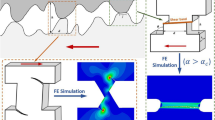Abstract
A two-dimensional linear-elastic fracture mechanics analysis of asperity cracking induced by adhesive normal contact was performed with the finite element method. Normal contact between two elastic asperities was analyzed with the equivalent contact system of an elastic asperity with equivalent radius of curvature and effective elastic modulus compressed by a rigid plane. Surface adhesion was modeled by nonlinear springs obeying a constitutive force-distance law derived from the Lennard–Jones potential. The maximum ranges of the tensile and shear stress intensity factors were used to determine the crack-growth direction and the dominant mode of asperity fracture in terms of the Maugis parameter (a function of the equivalent radius of curvature, work of adhesion, effective elastic modulus, and intermolecular equilibrium distance), friction coefficient at the crack interface, maximum surface interference, and crack position. Finite element simulation results indicate that the direction and the rate of crack growth are mostly affected by the Maugis parameter and the maximum surface interference. A transition from shear to tensile dominant mode of crack growth is encountered with the increase of the Maugis parameter and/or the decrease of the maximum surface interference. Opening, slip, and stick between the crack faces during loading and unloading are discussed in the context of crack mechanism maps.









Similar content being viewed by others
References
Archard JF (1953) Contact and rubbing of flat surfaces. J Appl Phys 24:981–988
Attard P, Parker JL (1992) Deformation and adhesion of elastic bodies in contact. Phys Rev A 46:7959–7971
Bassani R, D’Acunto M (2000) Nanotribology: tip-sample wear under adhesive contact. Tribol Int 33:443–452
Bradley RS (1932) The cohesive force between solid surfaces and the surface energy of solids. Philos Mag 13:853–862
Burwell JT, Strang CD (1952) On the empirical law of adhesive wear. J Appl Phys 23:18–28
Chan SK, Tuba IS, Wilson WK (1970) On the finite element method in linear fracture mechanics. Eng Fract Mech 2:1–17
Chaudhury MK, Weaver T, Hui CY, Kramer EJ (1996) Adhesive contact of cylindrical lens and a flat sheet. J Appl Phys 80: 30–37
Cho S-S, Komvopoulos K (1997) Thermoelastic finite element analysis of subsurface cracking due to sliding surface traction. ASME J Eng Mater Technol 119:71–78
Derjaguin BV (1934) Untersuchungen über die reibung und adhäsion: IV. Theorie des anhaftens kleiner teilchen. Kolloid Z 69:155–164
Derjaguin BV, Muller VM, Toporov YP (1975) Effect of contact deformations on the adhesion of particles. J Colloid Interface Sci 53:314–326
Dwyer-Joyce RS (1999) Predicting the abrasive wear of ball bearings by lubricant debris. Wear 233–235:692–701
Erdogan F, Sih GC (1963) On the crack extension in plates under plane loading and transverse shear. ASME J Basic Eng 85:519–527
Gong Z-Q, Komvopoulos K (2005) Contact fatigue analysis of an elastic-plastic layered medium with a surface crack in sliding contact with a fractal surface. ASME J Tribol 127:503–512
Greenwood JA (1997) Adhesion of elastic spheres. Proc R Soc Lond A 453:1277–1297
Israelachvili JN (1992) Intermolecular and surface forces, 2nd edn. Academic Press, San Diego
Jahanmir S, Suh NP (1977) Mechanics of subsurface void nucleation in delamination wear. Wear 44:17–38
Johnson KL, Kendall K, Roberts AD (1971) Surface energy and the contact of elastic solids. Proc R Soc Lond A 324:301–313
Johnson KL, Greenwood JA (1997) An adhesion map for the contact of elastic spheres. J Colloid Interface Sci 192:326–333
Johnson KL, Greenwood JA (2008) Maugis analysis of adhesive line contact. J Phys D Appl Phys 41:199802
Ko PL, Iyer SS, Vaughan H, Gadala M (2001) Finite element modeling of crack growth and wear particle formation in sliding contact. Wear 251:1265–1278
Komvopoulos K, Cho S-S (1997) Finite element analysis of subsurface crack propagation in a half-space due to a moving asperity contact. Wear 209:57–68
Leng YS, Hu YZ, Zheng LQ (2000) Adhesion of smoothly flat-ended wedges. Proc R Soc Lond A 456:185–204
Lisowski Z, Stolarski TA (1981) A modified theory of adhesive wear in lubricated contacts. Wear 68:333–345
Mageed AMA, Pandey RK (1992) Studies on cyclic crack path and the mixed-mode crack closure behaviour in Al alloy. Int J Fatigue 14:21–29
Maugis D (1992) Adhesion of spheres: the JKR-DMT transition using a Dugdale model. J Colloid Interface Sci 150:243–269
Muller VM, Yushchenko VS, Derjaguin BV (1980) On the influence of molecular forces on the deformation of an elastic sphere and its sticking to a rigid plane. J Colloid Interface Sci 77:91–101
Paris P, Erdogan F (1963) A critical analysis of crack propagation laws. ASME J Basic Eng 85:528–534
Sih GC (1974) Strain-energy-density factor applied to mixed mode crack problems. Int J Fract 10:305–321
Song Z, Komvopoulos K (2011) Adhesion-induced instabilities in elastic and elastic-plastic contacts during single and repetitive normal loading. J Mech Phys Solids 59:884–897
Suh NP (1973) The delamination theory of wear. Wear 25:111–124
Suh NP (1977) An overview of the delamination theory of wear. Wear 44:1–16
Tabor D (1977) Surface forces and surface interactions. J Colloid Interface Sci 58:2–13
Wu J-J (2009) Adhesive contact between a cylinder and a half-space. J Phys D Appl Phys 42:155302
Author information
Authors and Affiliations
Corresponding author
Rights and permissions
About this article
Cite this article
Xu, H., Komvopoulos, K. Fracture mechanics analysis of asperity cracking due to adhesive normal contact. Int J Fract 181, 273–283 (2013). https://doi.org/10.1007/s10704-013-9849-9
Received:
Accepted:
Published:
Issue Date:
DOI: https://doi.org/10.1007/s10704-013-9849-9




